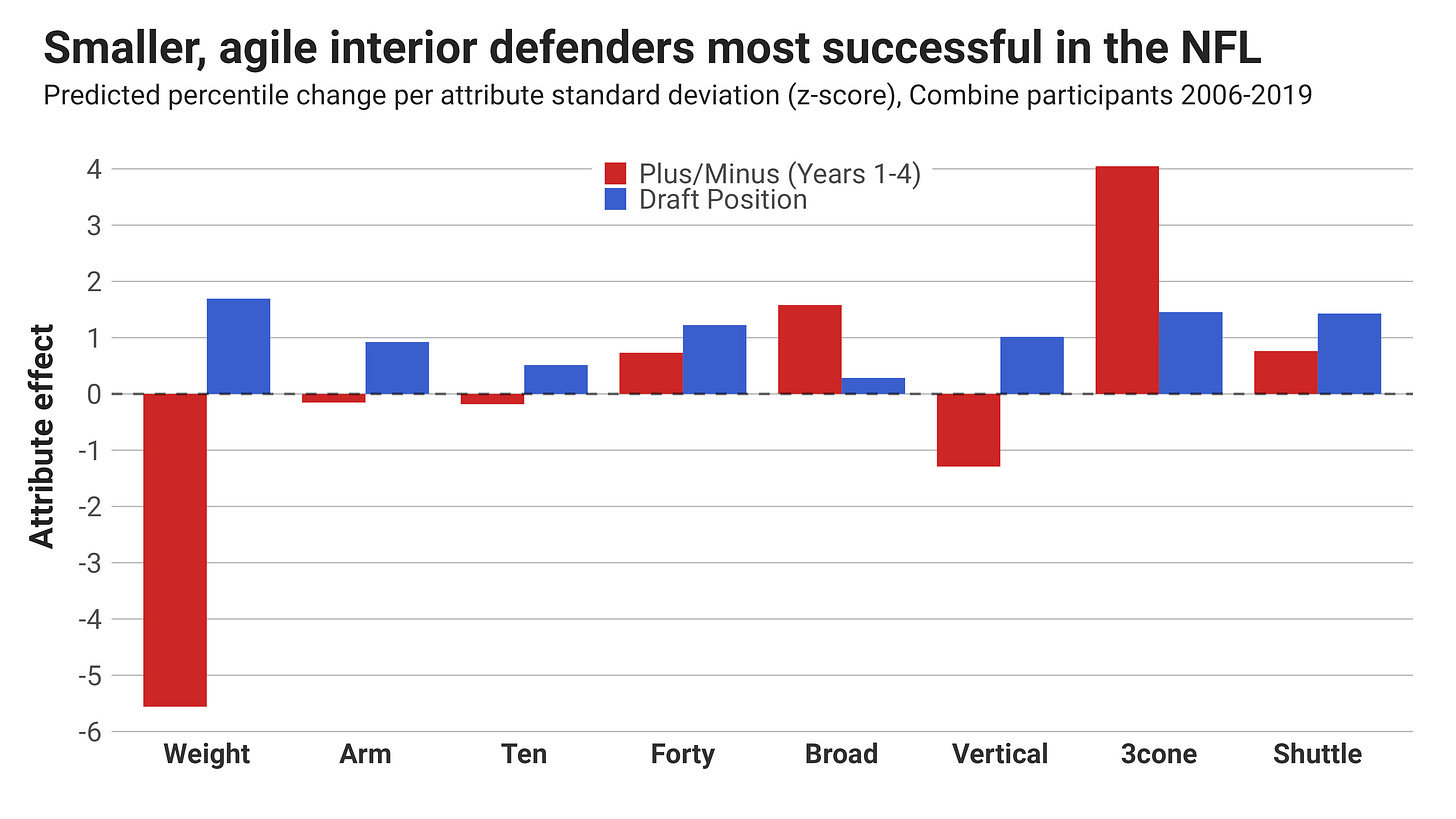Scouting Combine drills that matter for NFL success: Defensive positions
Looking back at 15-plus years of combine results to sort out what drills and measurements are most correlated with NFL success
The degree of importance of NFL Combine drills and measurements depends on what you’re looking to predict: draft position or actual player value. The former is known for all historical draft picks; the latter more estimation and shared understanding. I’ve attempt to push forward our understanding of non-quarterback player value with the NFL Plus/Minus metric, a universal, points-based measure.
The relationship between draft position and NFL value is fairly strong, but contrasting the two gives additional insight into systemic errors in over/underweighting certain traits and how teams can more productively harness information gathered at the combine. Yesterday I published the results for which drills correlate most with draft and real NFL value for offensive positions. Today, I turn to the defensive side of the ball.
METHODOLOGY
This analysis is built on strong work from former Harvard Sports Analysis Collective member Bill Lotter in his series detailing why the NFL Combine actually matters. Lotter used ridge regression to estimate the coefficients for the different Combine results and measure their importance in explaining prospects’ draft positions and value — the latter estimated using Pro Football Reference’s approximate value (AV) over players’ first three seasons.
Approximate value was a tremendous advancement in player valuation and the best public metric available to Lotter at the time of the analysis. The shortcomings of AV mostly relate to its focus on volume and the inability to differentiate between players on the same team for certain position groups that lack traditional stats, such as offensive linemen. Even for position groups with more extensive traditional stats such as tackles and sacks, their production can be more a function of luck and opportunity than adding value. This is where NFL Plus/Minus can truly add the proper context and weighting to the performance of each player. For my analysis, I’m contrasting Plus/Minus to draft position, in substitution of AV.
The plots below give the coefficient for each measurement or drill denominated by standard deviation within the position group. The draft positions and Plus/Minus for position groups are translated to percentile, giving both the same scale. Each bar below represents the amount of percentile movement you’d expect for a player with one standard deviation above or below the positional average.
The sample for this analysis covers all players who participated in all drills or all but one drill from 2006 to 2019. For players who missed a drill, the value was estimated through a regression on the remaining variables, with a discount applied to the result because of an assumption that the drill was purposely skipped with an expectation of underperformance. Players who participated in the combine and were not drafted are included in the sample with an assumed draft position of 300.
Below each plot, I’ve included a table with the top-10 projections for positional Plus/Minus (first four seasons) in the 2006 to 2022 period, including the players’ combine marks and their actual Plus/Minus produced.
INTERIOR DEFENDER
Interior defender begin a theme you’ll see at a few positions on defensive: bigger signal than offensive players for combine measurements and drills. There’s always the risk that these models are overfitting to a few productive players (See J.J. Watt below), but I think we can still take a lot from looking back at the past.
Weight-adjusted three-cone times jump out as a huge indicator of NFL success, and somewhat surprisingly a lower weight. Like all defensive players, interior defenders have dual responsibilities against the pass and run, but those roles have very different profiles at the positions. When you look Plus/Minus against the run and pass as target values separately, three-cone is significant for both, but above-average size is linked with run defense. In the modern NFL interior defenders have become increasingly important in rushing the passer, and that’s why the overall Plus/Minus correlation points to smaller, faster players for the best NFL value.
J.J. Watt was one of the most productive non-quarterbacks in recent memory by points added at 173.5 over his first four years, which translates to over one win added per season.





